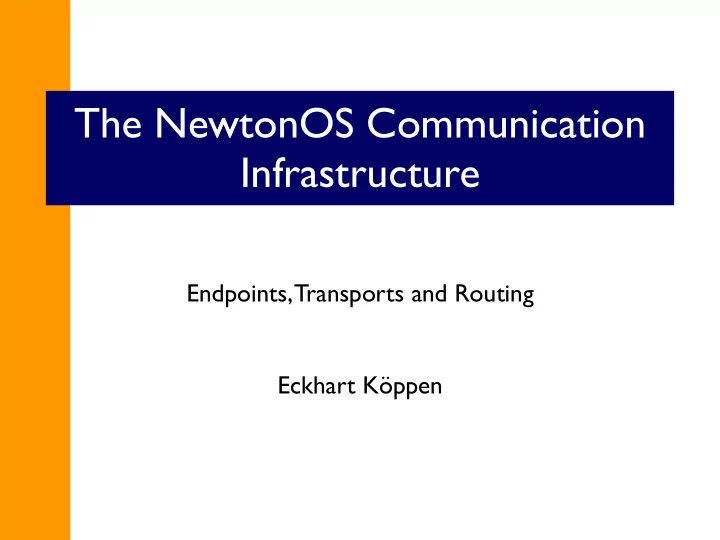

The NewtonOS Communication Infrastructure Endpoints, Transports and Routing Eckhart Köppen
Introduction • Why this talk? • What is covered, what not? • “Working mode of a hacker” • Feel free to interrupt and ask!
My Motivation • Bad handwriting – need to get data onto the Newton somehow else • Connected world – phones, desktops, servers, ... • Free GPRS connectivity! • Free test phones!
Covered Topics • Routing is quite complex • Will cover only basics of sending and receiving • Left out are e.g. print formats, application specific actions • Briefly touch low level implementation topics • Whatever comes to your mind!
Words of Caution • The Newton is an abandoned platform – excellent documentation, but some parts are not covered • Terminology in undocumented areas might differ • Working mode: try yo figure out as much as needed, not more – inconsistencies, unexplained areas or errors are to be expected • If in doubt, ask among developers
An Example • Sending a Names entry to your mobile phone • High level steps: • Pick the format for sending • Pick a transport method • Identify the receiving device • Open a connection • Send the data • Close the connection
Routing • First step is choosing a data format: plain text or vCard? • List of format choices defined by the type of the data • Types are referred to as “classes” • The class is always part of the data object • A “Route Script” is responsible for the formatting, it claims that it can handle specific classes • List of registered “Route Scripts” checked, those which support the current data type are listed as format choices in the Route Slip
Routing Result • The Names entry will be formatted as a vCard, but the underlying type is text • Other types (or classes) are e.g. views for printing or binary data • The Route Script defines which data format (text, views or binary) it produces
Transports • Now what to do with the chosen data format? • The system checks how the data format can be transported • “Transports” are responsible for taking data and sending it • A Transport defines which data types it can handle • Data types relevant here are the ones produced by the Route Scripts • System searches list of transports for matching ones • Transports usually implement protocols, so lets transfer the vCard over OBEX
Endpoints • Transports need a physical connection • Endpoints know all about that, this is the “wire” level • Endpoint functionality is to send raw data • OBEX in this example is interesting as it can run over different “wires” • Here we finally cross into the low-level NewtonOS (more later)
Putting Things Away • Receiving data is quite different • Common parts are Endpoints (”Wires”) and Transports (”Protocols”) • Data will end up in the Inbox • Route Scripts are not involved • Instead, applications register for different data types • The initial data type is set by the receiving Transport • In OBEX, the data type can be part of the protocol • File extensions can also be used
What Makes This So Special? • Ideal split of the responsibilities for adding functionality • Easy to add e.g. new data formats • No dependencies between the components • Added functionality available for all related parts – new data formats can be used over all transports • Nothing comparable on mainstream platform, data is boxed in • Data on the Newton is easily accessible (Names, Dates, Notes, ...) and can be reused
The Example Refined • How are these things implemented? • Route Scripts: IC/VC • Transports: Neo • Endpoint: Blunt
Routing – IC/VC • IC/VC is a collection of route scripts and can also handle putting away items from the Inbox • It registers to handle Names and Dates data types • Output of the route scripts is plain text • Every transport which can handle plain text can now send e.g. vCards • Putting away is possible for vCard and iCal data, but the target applications are unfortunately not Names and Dates • Easier to implement this way • More a UI problem
Transport – Neo • Neo implements parts of the OBEX protocol as a client and server • OBEX is independent of the “wire” level • Much code reused between the Bluetooth, IrDA and TCP/IP OBEX implementations • Only significant differences are which Endpoint type is used – more more precisely, which Comm Tool is involved
Endpoint – Blunt • Blunt does not directly implement an Endpoint • Endpoints are also high level constructs • They are layered on top of the actual physical connection components, the Comm Tools
Blunt as a Comm Tool • The low level NewtonOS is quite different from the NewtonScript world, is is a whole set of new and undocumented concepts • Some similarities in concepts to MacOS before X • Blunt is realized as a CommT ool, using a generic serial chip interface • A specific serial chip is chosen on initialization, the system wide setting is done in “Bluetooth Setup”
References and Documentation • IC/VC, Neo, Blunt: http://40hz.org/ • Blogging the hacking efforts: http://40hz.org/mottek/ • Mandatory documentation: http://www.unna.org/unna/ development/documentation/ • Strongly recommended: Programming for the Newton Using Macintosh by McKeehan/Rhodes (also on UNNA!) • Advanced but good: Wireless for the Newton by McKeehan/ Rhodes
Recommend
More recommend